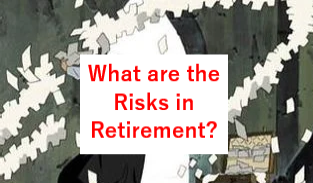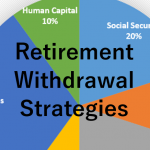Risks in Retirement
Retirement is not the time to start living, but it certainly isn’t the time to start dying either!
Once you have purpose nailed—what you are retiring to?—it is time to consider some of the risks in retirement.
Remember, accumulating assets is easy compared to figuring out how to spend them! Well, nothing is easy in the financial world. It doesn’t pay wall street to make it easy, so one must always watch out for complexity. And not to be too flippant: for some, saving is difficult. We have talked a little about spending in retirement and how it changes over time. In addition, we talked about strategies for retirement withdrawal and mentioned some products that may help mitigate risks.
But what are the main risks to be concerned with during retirement?
Risk mitigation is foundational to retirement planning! Not only do you have to find a way to convert your nest egg into cash for the next 30+ years, you must consider and mitigate known risks.
Let’s look at the most common retirement risks and start to think about mitigation strategies. These risks, at the very least, need attention prior to retirement.
Stuck in Accumulation Mode
Retirement is all about turning assets into income. How do you convert your assets into money to spend? In fact, this is often backwards to the beginner retiree. Wait, I have to spend down my assets? After decades of seeing net worth increase, it is ok to have net worth drop. Issues that need consideration: long term cash flow planning, liquidity, spending shocks, and especially important, moving on from the accumulation mindset to a de-accumulation one.
If you get stuck in the accumulation mode, there can be several problems. Not only do you worry about spending down your assets appropriately, you can also ignore hedging your bets and covering the other risks out there. Let’s next talk about the three major risks you face in retirement.
The Three Major Risks You Face In Retirement
Sequence of Returns Risk
Sequence of Returns Risk may be the largest challenge soon-to-be retirees face. This is because it happens only around the time of retirement. Sequence risk, however, is also easy to plan for!
We will have a whole chapter devoted to sequence of returns risk, but understand that you must plan for this risk well in advance of retirement. The last thing you ever want to do is sell your assets when they are low, and in fact I call this the cardinal rule of investing: don’t sell low!
If you retire and the market tanks, you might be forced to sell low. This poor sequence of market returns can then plague the rest of your retirement.
Most people don’t retire into a poor sequence, but you have to plan as if you will! If you don’t, you will be better off than you planned for the rest of your retirement, but that is better than the alternative!
Longevity
Longevity is better than the alternative! Some say longevity risk is the only risk, as all other risks are exacerbated by time. In fact, longevity is the great multiplyer of all other risks. If you die shortely after retirement, then almost any retirement plan will work out ok.
But you need to plan to live a long life. And in fact, aside from financial issues which all are exacerbated by time, there are cognitive and health issues to consider as well.
Longevity is also important enough to have its own chapter.
Inflation
Inflation may be a sleeping dragon. Delaying social security until you are 70, and having adequate exposure to equities in the stock market are obvious solutions. But remember what food used to cost you 20 years ago, and remember prices will at least double during your retirement.
There are also inflation-linked fixed securities to consider in your tax-sheltered accounts, and most retiree’s should consider devoting a portion of their assets to these.
Unfortunately, there are no perfect solutions to the problems caused by inflation. There are some inflation-linked products sold by insurance companies, but you will often find these too expensive to be worth your time. The insurance companies like to understand exactly what risks they are assuming, and no one can predict what inflation will be in the future!
I deal with inflation during the chapter on longevity. After all, inflation is in fact negative compounding on your spending ability, and it is only a problem if you live a long life!
Other Risks to Consider
Beyond the three largest risks that you face in retirement, there is a hodge podge of other concerns. Sign up on the right of the screen for my Retirement Check list and you will get a complete list of the retirement risks you need to consider, but let’s also look at a few lessor risks now.
Asset Allocation
Portfolio risk and asset allocation are important considerations. You must invest your assets wisely and be diversified. Understand your risk tolerance and why asset allocation is important to prevent the one cardinal sin of investing: selling low and locking in losses. The wise pre-retiree wants to be de-risked by about 5 years before retirement. A total market return mindset is important, as are fixed income and fixed income alternatives. You must be invested appropriately to hedge for the many possible futures.
The Tax Man
Taxes are the largest expense in retirement. Tax efficiency, tax diversification, and future tax rate policy risk are important considerations and at the very base of a comprehensive retirement plan. Partial Roth conversions will be an important consideration for many as a mitigation strategy, as taxes are the only retirement expense you can truly pre-pay. I consider taxes so important, that taxes in retirement are chapter 1!
Illness and Wealth
Health is truly important in all phases of life, but even more so in retirement. When you slow down a bit, you might have a little more time on your hands to improve your health. An exercise and diet plan is every bit as important as anything else in retirement!
Insurance, such as Medicare, supplemental insurance, and Long-Term Care insurance are sure to challenge you intellectually, as they are among the most difficult considerations in retirement. You can be sure your spending on healthcare will increase in the last few years of a long retirement, so balancing reserves with current spending is important. There are future chapters on Medicare and Long-Term Care Insurance in the works.
Spousal Issues
No one wants to talk about grey divorce, or death of their spouse. Emotions run high in these discussion, but it is important to consider loss of your spouse. Expenses don’t go down by 50% when there is loss, but income almost certainly drops at least by the amount of the smaller social security payment.
If you are married, you need to run your retirement plan two more times, one each considering what would happen if a spouse dies early. This will not deal with the emotional impact of such a tragic event, but the last thing you want to worry about when a spouse dies early is money.
What Retirement Risks are Just Scare Tactics?
There are a few risks that I do not consider worthy of planning for. Which risks are Scare Tactics?
Let’s be honest, there are a lot of people out there who make money off you. This is the service industry that is the engine behind the American economy.
While we don’t expect services for free, one does need to worry about being taken advantage of. Especially when dealing with money or products designed for retirement. After all, how easy is it to skim off a percent here and a commission there when considering money. You personally don’t need to be an expert in all things finance, but you do need to understand how a provider of service is being paid. Equally as important, you must understand incentives. There is a great saying by Upton Sinclair which is important to remember: “It is difficult to get a man to understand something, when his salary depends on his not understanding it.”
Which risks are scare tactics?
Market Volatility
A great example is market volatility. If you watch the financial news media, you would think that a one-day sharp decline in the market is a national tragedy. A sharp drop in stock prices either in a day or over several months is just the cost of admission for investing. It is to be expected!
Wall street uses the “risk of market loss” as a strategy intended to manipulate you into fear. On the contrary, volatility is why we actually invest in the stock market. It is what brings a risk premium for stocks over bonds!
The only time you need to worry about volatility is when you are at risk for a poor sequence of returns. That topic will be covered extensively. Beyond that, ignore the financial media, as their incentives don’t align with yours.
Social Security Risk
This is a big one! Financial pundits use the fear of social security loss to get your eyeballs and attention.
Social security will not go broke, but there could be a reduction in benefits. Remember, however, that the way benefits have been reduced in the past is by increasing the retirement age and by increasing taxation of social security. And these changes are phased in, so they just affect people who have some time to adjust to the changes.
If you truly need social security to survive retirement, chances are there will be no cuts to your monthly check. This is especially true if you are close to claiming.
On the other hand, if you have other assets, it is almost certain that the taxation of social security will increase. You paid in more during your working years, and you get less out in retirement. This is not a risk because you just need to assume it will be true. If you have other assets, it still pays to wait as long as you can to claim social security and just deal with the reduction in benefits. Plan for it to happen, and be pleasantly surprised if it doesn’t.
Summary—What are the Risks in Retirement?
A single risk will often not sink your plan. It is risk of multiple risks that you need to be wary of.
Once you understand some of the risks to watch out for, you can make a plan.
Remember, you have to start at the beginning: determine your goals! It is always a good time to retire if you have a plan!



Your comment is awaiting moderation.
Thanks a lot for the helpful post. It is also my belief that mesothelioma has an particularly long latency interval, which means that symptoms of the disease would possibly not emerge till 30 to 50 years after the first exposure to asbestos fiber. Pleural mesothelioma, that is the most common kind and influences the area around the lungs, could cause shortness of breath, chest pains, and also a persistent cough, which may lead to coughing up blood. Chang Tibbit